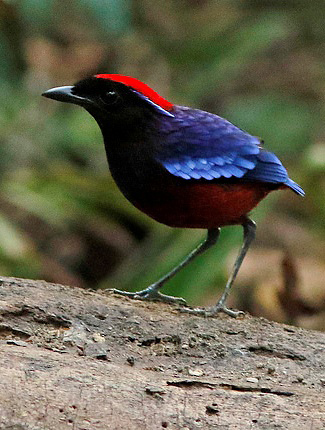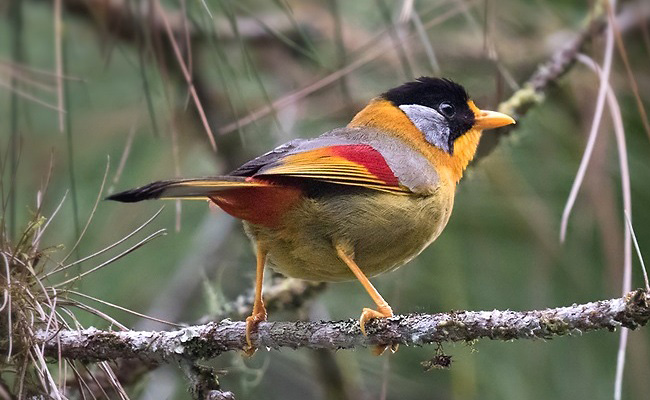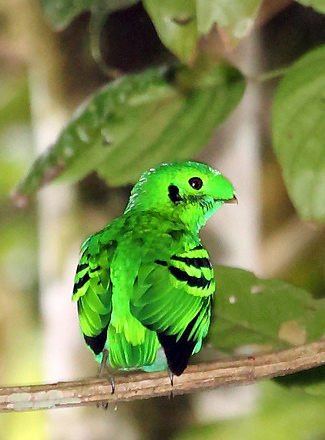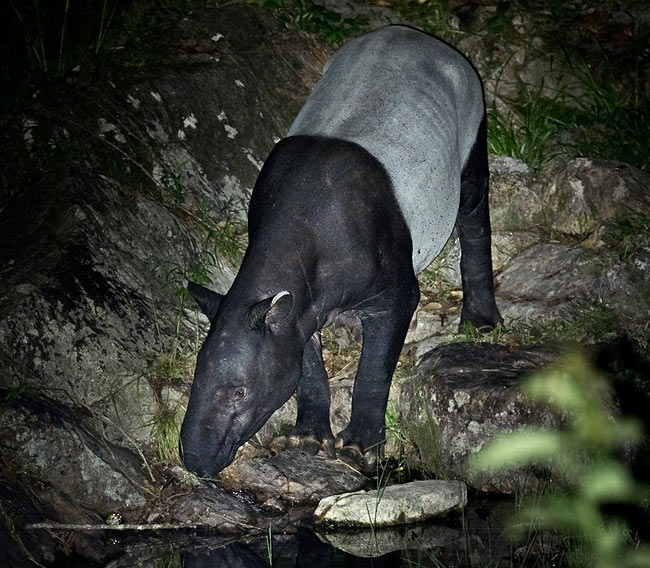

A fabulous Garnet Pitta in the Krau Forest of Malaysia by David Beadle.
the
- A long list of fabulous South-East Asian birds, including trogons, kingfishers, bee-eaters, barbets, broadbills, hornbills, woodpeckers, pittas, leafbirds, babblers and sunbirds
- And some of Asia’s and the world’s most spectacular localized birds including Great Argus, Malay Banded Pitta, Garnet Pitta, Blue Nuthatch and Rail-babbler
- As well as some beautiful primates including Siamang and White-handed Gibbon
- And a chance of Malayan Tapir
- In possibly the oldest lowland rainforest on
the planet, complete with a 500 metre long
canopy walkway, at Taman Negara - With rich coral reefs offshore
- Some tour companies combine the Malay Peninsula with Borneo where additional delights include Orang-utan, Proboscis Monkey, Bornean Gibbon, six Bornean endemic birds that occur only in Malaysia (the north end of the island); Sabah (Chestnut-necklaced) Partridge, Dulit Partridge, Bornean (Cave) Swiftlet, Black-crowned Pitta, Friendly Grasshopper-warbler and Everett’s Thrush, and other spectacular birds endemic to Borneo such as Hose's and Whitehead's Broadbills, Whitehead's Trogon, Blue-banded and Blue-headed Pittas, Bornean Bristlehead and Whitehead's Spiderhunter.

The amazing Silver-eared Mesia, at Fraser's Hill, by Lars Petersson.
Best Birds and other wildlife in the Malay Peninsula
Birds
Malay Peninsula Endemics 4
Malay Partridge, Mountain Peacock-pheasant, Malay Whistling-thrush and Malay (Brown) Bullfinch.
Near-endemics
Malay Peninsula and Thailand 2 Malay Peacock-pheasant and Malay Laughingthrush.
Malay Peninsula, Thailand and Myanmar 6 White-fronted Scops-owl, Plain-pouched Hornbill, Bamboo Woodpecker, Rufous-bellied (Red-rumped) Swallow, Olive Bulbul and Chestnut-winged Babbler.
Malay Peninsula, Thailand, Myanmar and Sumatra 4 Malay Crested Fireback, Malay Brown Barbet, Malay Black Magpie and Buff-vented Bulbul.
Malay Peninsula, Thailand and Sumatra 4 Fire-tufted Barbet, Malay Banded Pitta, Cinereous Bulbul and Marbled Wren-babbler.
Malay Peninsula and Sumatra 6 Chestnut-necklaced Partridge, Malay Crestless Fireback, Black-browed Barbet, Chestnut-capped Laughingthrush, Black Laughingthrush and Rufous-vented Niltava.
Malay Peninsula, Sumatra and Borneo 1 Grey-breasted Babbler.
Malay Peninsula and Borneo 1 Brown-backed Flycatcher.
Malaysia and Philippines 1 Palawan Frogmouth (Banggi Island in Malaysia).
Malay Peninsula, Vietnam and Laos 1 Crested Argus.
Other specialities
Great Argus, Garnet and Mangrove Pittas, Rail-babbler, Blue Nuthatch, Straw-headed Bulbul, and Large and Striped Wren-babblers.
Others
Red Junglefowl, Crested, Ferruginous and Long-billed Partridges, Chinese Pond-heron, Cinnamon Bittern, Brahminy Kite, Lesser Fish-eagle, Rufous-bellied
Eagle, Blyth’s Hawk-eagle, Black-thighed Falconet, green-pigeons, Blue-crowned Hanging-parrot, Blue-rumped Parrot, Violet Cuckoo, malkohas, Reddish and
Mountain Scops-owls, Collared Owlet, Malay Eared-nightjar, Germain’s Swiftlet, Brown-backed and Silver-rumped Needletails, Whiskered Treeswift, Diard’s,
Orange-breasted, Red-headed, Red-naped and Scarlet-rumped Trogons, Banded, Black-capped, Blue-banded, Collared, Rufous-collared and Stork-billed
Kingfishers, Red-bearded, Blue-tailed and Blue-throated Bee-eaters, piculets, Greater and Lesser Yellownapes, Common and Greater Flamebacks,
Crimson-winged, Great Slaty and Orange-backed Woodpeckers, hornbills, Banded, Black-and-red, Black-and-yellow, Dusky, Green and Long-tailed Broadbills,
Maroon-breasted and Rufous-winged Philentomas, White-breasted Woodswallow, Grey-chinned and Scarlet Minivets, Golden-bellied Gerygone, Green Iora, Pied
Triller, Mangrove Whistler, Black-eared and White-browed Shrike-babblers, orioles, leafbirds, Asian Fairy-bluebird, Greater Racquet-tailed and Lesser
Racquet-tailed Drongos, fantails, Black-naped Monarch, Asian Paradise-flycatcher, Crested Jay, Common Green Magpie, Sultan Tit, Velvet-fronted Nuthatch,
bulbuls including Scaly-breasted, tailorbirds, leaf-warblers, Slaty-backed and White-crowned Forktails, flycatchers including Mangrove Blue and Pygmy Blue,
Large Niltava, White-rumped Shama, babblers, wren-babblers, Chestnut-backed Scimitar-babbler, laughingthrushes, Silver-eared Mesia, Long-tailed Sibia,
Asian Glossy Starling, Common Hill Myna, flowerpeckers, sunbirds and spiderhunters.
Also a chance of Watercock, White-browed Crake, Pheasant-tailed Jacana, Greater Painted-snipe, Buffy Fish-owl, Brown Wood-owl, Gould’s and Large Frogmouths, Jambu Fruit-dove, Silver-breasted Broadbill, Blue-winged, Western Hooded and Rusty-naped Pittas, Himalayan Cutia and Chestnut-naped Forktail.
Mammals
Siamang, White-handed Gibbon, Banded, Dusky and Silvered Langurs, Long-tailed (Crab-eating) Macaque, Red Giant
Flying Squirrel, Sunda Flying Lemur (Colugo), Sunda Slow Loris, Sambar, Cream-coloured and Black Giant Squirrels, Prevost's Squirrel, Malayan, Asian
Palm and Small-toothed Palm Civets, Common (Southern) Tree Shrew, Sambar, Greater Mouse and Lesser Mouse Deer, Indian Muntjac, Wild Boar and
Long-tailed Giant Rat. Also a chance of Malayan Tapir (mostly at mineral licks and particularly in July at the peak of the dry season), Asiatic
Brush-tailed Porcupine and Smooth-coated Otter.
Reptiles, Amphibians and Fish
Water Monitor, flying lizards and numerous coral reef fish. Also a chance of Green,
Hawksbill and Leatherback Turtles.
Invertebrates
A rich diversity of butterflies including Common and Rajah Brooke's Birdwings, and the chance to see
synchronised Fireflies at Kuala Selangor.
Plants
The lowland rainforest in Taman Negara, the largest tract of ‘protected’ lowland rainforest on mainland South East
Asia, is estimated by some to be about 130 million years old, making it possibly the oldest rainforest on Earth. It is also the richest forest in the
world in terms of tree species.
Best Sites for Birds and other wildlife in the Malay Peninsula
- Berjaya Hills A chance of Mountain Peacock-pheasant, Ferruginous Partridge and Rhinoceros Hornbill.
- Krau Forest Scarlet-rumped Trogon, Rufous-collared Kingfisher, Blue-throated Bee-eater, Dusky Broadbill, Banded and Garnet Pittas, bulbuls and babblers. Also a chance of Jambu Fruit-dove.
- Kuala Selangor Black-capped and Stork-billed Kingfishers, Mangrove Whistler and Mangrove Blue-flycatcher. Also a chance of Buffy Fish-owl, Mangrove Pitta, Silvered Langur, Smooth-coated Otter and synchronised Fireflies.
- Fraser's Hill Dusky and Long-tailed Broadbills, Fire-tufted Barbet, Orange-breasted and Red-headed Trogons, Common Green Magpie, Sultan Tit, Blue Nuthatch, Malayan Whistling-thrush, Black, Chestnut-capped and Malay Laughingthrushes, Red-bearded Bee-eater, Black-eared Shrike-babbler, Marbled and Streaked Wren-babblers, Silver-eared Mesia, Siamang, White-handed Gibbon, Banded and Dusky Langurs, and Rajah Brooke’s Birdwing. Also a chance of hornbills, Ferruginous, Long-billed and Malay Partridges, Brown Wood-owl, Silver-breasted Broadbill, Himalayan Cutia (Pine Tree Trail) and Rusty-naped Pitta (Bishop's Trail).
- Taman Negara Great Argus, Malay Crested Fireback, Blue-banded and Rufous-collared Kingfishers, Red-bearded Bee-eater, Malay Banded and Garnet Pittas, Black-and-red, Black-and-yellow and Green Broadbills, Sultan Tit, Rail-babbler, and Grey-bellied, Scaly-breasted and Streaked Bulbuls, some of which may be seen from the 500 metre long canopy walkway, as well as White-handed Gibbon, Sunda Flying Lemur, Sunda Slow Loris and Red Giant Flying Squirrel. Also a chance of Malay Peacock-pheasant, Crested Partridge, Gould’s and Large Frogmouths (both at Merapoh entrance, along with Reddish Scops-owl), Jambu Fruit-dove, Diard's and Red-naped Trogons, hornbills, Blue-winged and Hooded Pittas, Brown-chested Jungle Flycatcher, Straw-headed Bulbul, Chestnut-naped Forktail, and Large and Striped Wren Babblers, as well as Malayan Tapir (mostly from hides overlooking mineral licks, especially Kumbang Hide), Gaur and civets.
- Malim Mawar near Batu Gajah A chance of waterbirds such as bitterns, Watercock, White-browed Crake, Pheasant-tailed Jacana and Greater Painted-snipe.
- Bukit Larut (Maxwell Hill) A chance of Red-bearded Bee-eater, Long-tailed Broadbill, Sultan Tit and Blue Nuthatch.
- Belum FR/Royal Belum SP A chance of all ten hornbills which occur on the Malay Peninsula.

The amazing Green Broadbill by Nigel Voaden.

A Malayan Tapir captured on camera at night in Taman Negara by Lars Petersson.
- Southern Peninsula
- Panti Forest Reserve Cinnamon-headed Green-pigeon, Whiskered Treeswift, Red-bearded Bee-eater, Red-crowned Barbet, bulbuls such as Black-and-white, and babblers. Also a chance of Crested Partridge, Cinnamon-rumped and Red-naped Trogons, Garnet Pitta, Rail-babbler and Scarlet-breasted Flowerpecker.
- East Coast and Offshore
- Terengganu Leatherback Turtle nests at Rantau Abang (mostly May-Sep).
- Palau Redang Turtles and large groupers.
- Palau Perhentian Excellent scuba-diving and snorkeling with a chance of Green and Hawksbill Turtles.
Best Times for Birds and other wildlife in the Malay Peninsula
Any time between March and October is a good time to visit the Malay Peninsula, although March is a particularly good time for birds, as is July, at the peak of the dry season, which is also the best time to look for Malayan Tapirs visiting mineral licks. The wet season, when it can be very wet, usually lasts from November to February.
Recommended Bird Books etc. for the Malay Peninsula
A Field Guide to the Birds of Peninsular Malaysia and Singapore by A Jeyarajasingam. OUP, 2012. (Second Edition).
Birds of South-East Asia by C Robson. Helm, 2018. (Second Edition)
Birds of South-East Asia Concise Edition by C Robson. Helm, 2015.
A Field Guide to the Mammals of South-East Asia by C M Francis. New Holland Publishers, 2008.
A Field Guide to the Reptiles of South-East Asia by I Das. Bloomsbury, 2015.
Where to watch birds in Asia by N Wheatley. Helm, 1996.
Don’t know which country/countries/regions to visit in Asia? Then it may be worth considering taking a look at this book, written by this website’s author. It is many years old of course but it still provides a starting point, an overview and a guiding light to the best birds and the best places to look for them in the region, and could save hours of searching for similar information on the internet. However, it is important to check more up-to-date sources for sites which have been opened up, sites and species which have been discovered, lodges that have been built etc. since the book was published.
Birding and Wildlife Trip Reports for the Malay Peninsula
Many trip reports, some for the Malay Peninsula, are posted on the websites listed here. On some of these websites some reports are independent and some are posted by tour companies who organize tours to the Malay Peninsula. These tour companies and others also post their own reports on their websites, which are listed under 'Some Organized Tours to the Malay Peninsula' below.
- The best website for trip reports is CloudBirders
- but these are also worth a look
- Birdtours
- Fatbirder
- Jon Hornbuckle
- Mammal Watching
Local bird and wildlife guides in Malaysia
The costs of organized tours partly reflect the quality of the tour leaders. Some leaders are certainly better than others and many companies claim their leaders are the best but even the best rely at least to some extent on the exceptional skills of the local guides they employ. If you are travelling independently, employing such local guides will greatly increase your chances of seeing the wildlife you wish to see.
- Bird Malaysia
- by Birders, for Birders and the Birds
- “With over 25 years experience, Bird Malaysia offers the best spots and time for birds and the best accommodation for our fellow birdies. Our tours are designed to ensure a comfortable and successful birdwatching experience. We look forward to welcoming and guiding you through Malaysia!”
- Irshad Mobarak – Birder & founder.
- Nature2Pixel
- Nature2pixel plans and conducts recreational trips for wildlife watching and photography. Travel with us and explore our country to watch and take photographs of birds, butterflies and bugs. We are as enthusiastic as you are! Check us out at www.nature2pixel.my.
Accommodation for birders in the Malay Peninsula
Some Organized Tours for birds and other wildlife to the Malay Peninsula
There are many tour companies who organize tours to see mammals, birds, other wildlife and other natural wonders. The cost of these tours vary considerably according to such variables as the airlines used, the number of days the tours last, the number of sites visited, the number of people in the group (an important consideration if you wish to see such wildlife as rainforest mammals and birds), the number of tour leaders, the standard of accommodation and transport, and the percentage profit the company hopes to make. Generally, where the number of days tours last and the number of sites visited are similar, the cheapest tours are those that use the cheapest airlines, accommodation and local transport, that have the largest groups with the least number of leaders, and that make the least amount of profit. The most expensive tours tend to be those which are exceptionally long, use the most expensive accommodation (ridiculously lavish in some cases, even for single nights) and which make the most profit. Some tour costs partly reflect the quality of the tour leaders. Some leaders are certainly better than others and many companies claim their leaders are the best but even the best rely at least to some extent on the exceptional skills of the local guides they employ.
While tour companies organize tours with set itineraries many also organize custom tours for individuals and private groups who instead of taking a tour with a set itinerary want to follow their own itinerary to suit their own personal tastes, whether it be mammals, birds, other wildlife, other natural wonders or even man-made attractions, or a mixture of them all. Many organized tours with set itineraries are also fast-paced and target as many species as possible, whether they are mammals, birds or other wildlife or everything, which usually leaves little time to enjoy the best sites and individual species, but on a custom tour those taking part can specify the pace and the sites and species they wish to concentrate on. Custom tours also suit people who like to travel with people they already know, rather than with a group of strangers, and people with partners with different interests. Individuals and small groups will almost certainly have to pay more than the price of an organized tour with a set itinerary but a large group of friends may be able to travel for less than the price quoted for a set tour.
Tour companies who are running organized tours to the Malay Peninsula in the next couple of years include the following. Many of these also offer custom tours.
